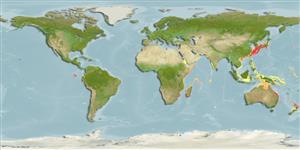>
Ophidiiformes (Cusk eels) >
Carapidae (Pearlfishes) > Pyramodontinae
Etymology: Eurypleuron: Greek, eurys = long + Greek, pleura = near, the side of (Ref. 45335); owasianum: Named for its type locality (Ref. 5275).
Environment: milieu / climate zone / depth range / distribution range
Ecologie
marien bathydemersaal; diepte 1 - 455 m (Ref. 34024). Deep-water
Northwest Pacific: Japan. Pending a comprehensive study of the group, E. owasianum is restricted to Japan and tentatively refer all of the disjunct southern populations to E. cinereum, the only species name available for the complex.
Grootte / Gewicht / Leeftijd
Maturity: Lm ? range ? - ? cm
Max length : 23.6 cm TL mannelijk / geslacht onbekend; (Ref. 5275)
Eel-like, shallow body depth; dorsal fin origin about opposite anal fin origin; males with expanded parapophyses on vertebrae 5 to 18-20; lacking cardiform premaxillary teeth, pelvic fins, swim bladder rocker bone, and ventral tunic ridges on posterior swim bladder (Ref. 34024).
Uncommon species (Ref. 34024). Presumably free-living (Ref. 34024).
Levenscyclus en paargedrag
Maturiteit | Voortplanting | Paaien | Eieren | Fecunditeit | Larven
Nielsen, J.G., D.M. Cohen, D.F. Markle and C.R. Robins, 1999. Ophidiiform fishes of the world (Order Ophidiiformes). An annotated and illustrated catalogue of pearlfishes, cusk-eels, brotulas and other ophidiiform fishes known to date. FAO Fish. Synop. 125(18):178p. Rome: FAO. (Ref. 34024)
Status op de Rode Lijst van het IUCN (Ref. 130435)
Gevaar voor de mens
Harmless
Gebruik door de mens
Visserij: van geen belang
Meer informatie
Lokale namenSynoniemenMetabolismePredatorenEcotoxicologieVoortplantingMaturiteitPaaienPaaiaggregatiesFecunditeitEierenOntwikkeling van de eieren
ReferentiesAquacultuurAquacultuurprofielKweeklijnenGeneticaElectrophoresesErfelijkheidZiektesVerwerkingNutrientsMassaconversie
Tools
Speciale rapporten
Download XML
Internetbronnen
Estimates based on models
Preferred temperature (Ref.
123201): 14.1 - 23.8, mean 19.3 °C (based on 180 cells).
Fylogenetische diversiteitsindex (Ref.
82804): PD
50 = 0.7500 [Uniqueness, from 0.5 = low to 2.0 = high].
Bayesian length-weight: a=0.00102 (0.00046 - 0.00225), b=3.06 (2.88 - 3.24), in cm total length, based on all LWR estimates for this body shape (Ref.
93245).
Trofisch niveau (Ref.
69278): 3.6 ±0.5 se; based on size and trophs of closest relatives
Fishing Vulnerability (Ref.
59153): Low vulnerability (14 of 100).
